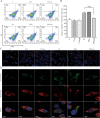Optimized allotopic expression of mitochondrial ND6 transgene restored complex I and apoptosis deficiencies caused by LHON-linked ND6 14484T > C mutation
- PMID: 37537557
- PMCID: PMC10399063
- DOI: 10.1186/s12929-023-00951-1
Optimized allotopic expression of mitochondrial ND6 transgene restored complex I and apoptosis deficiencies caused by LHON-linked ND6 14484T > C mutation
Abstract
Background: Leber's hereditary optic neuropathy (LHON) is a maternally inherited eye disease due to mutations in mitochondrial DNA. However, there is no effective treatment for this disease. LHON-linked ND6 14484T > C (p.M64V) mutation caused complex I deficiency, diminished ATP production, increased production of reactive oxygen species (ROS), elevated apoptosis, and impaired mitophagy. Here, we investigated if the allotopic expression of human mitochondrial ND6 transgene corrected the mitochondrial dysfunctions due to LHON-associated m.14484T > C mutation.
Methods: Nucleus-versions of ND6 was generated by changing 6 non-universal codons with universal codons and added to mitochondrial targeting sequence of COX8. Stable transfectants were generated by transferring human ND6 cDNA expressed in a pCDH-puro vector into mutant cybrids carrying the m.14484T > C mutation and control cybrids. The effect of allotopic expression of ND6 on oxidative phosphorylation (OXPHOS) was evaluated using Blue Native gel electrophoresis and extracellular flux analyzer. Assessment of ROS production in cell lines was performed by flow cytometry with MitoSOX Red reagent. Analyses for apoptosis and mitophagy were undertaken via flow cytometry, TUNEL and immunofluorescence assays.
Results: The transfer of human ND6 into the cybrids carrying the m.14484T > C mutation raised the levels of ND6, ND1 and ND4L but did not change the levels of other mitochondrial proteins. The overexpression of ND6 led to 20~23% increases in the assembly and activity of complex I, and ~ 53% and ~ 33% increases in the levels of mitochondrial ATP and ΔΨm in the mutant cybrids bearing m.14484T > C mutation. Furthermore, mutant cybrids with overexpression of ND6 exhibited marked reductions in the levels of mitochondrial ROS. Strikingly, ND6 overexpression markedly inhibited the apoptosis process and restored impaired mitophagy in the cells carrying m.14484T > C mutation. However, overexpression of ND6 did not affect the ND6 level and mitochondrial functions in the wild-type cybrids, indicating that this ND6 level appeared to be the maximum threshold level to maintain the normal cell function.
Conclusion: We demonstrated that allotopic expression of nucleus-versions of ND6 restored complex I, apoptosis and mitophagy deficiencies caused by the m.14484T > C mutation. The restoration of m.14484T > C mutation-induced mitochondrial dysfunctions by overexpression of ND6 is a step toward therapeutic interventions for LHON and mitochondrial diseases.
Keywords: Allotopic expression; Apoptosis; Complex I; Leber’s hereditary optic neuropathy; Mitochondrial DNA mutation; Mitophagy.
© 2023. National Science Council of the Republic of China (Taiwan).
Conflict of interest statement
All authors have no proprietary or commercial interest in any of materials discussed in this article.
Figures









References
MeSH terms
Substances
Grants and funding
LinkOut - more resources
Full Text Sources

